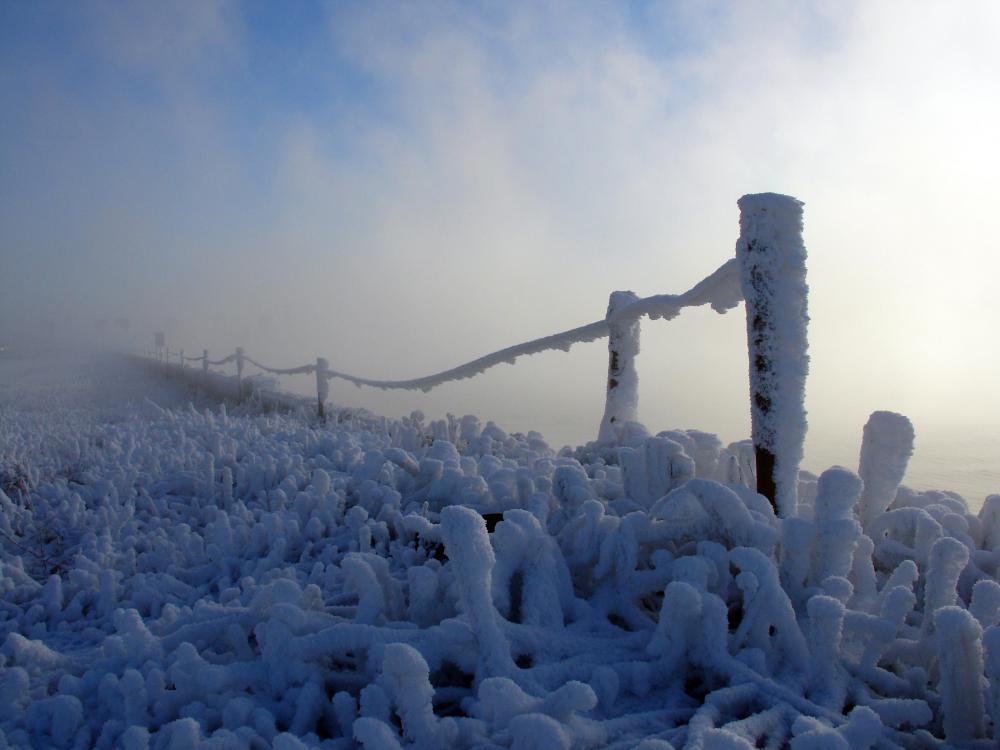At AllThingsNature, we're committed to delivering accurate, trustworthy information. Our expert-authored content is rigorously fact-checked and sourced from credible authorities. Discover how we uphold the highest standards in providing you with reliable knowledge.
What is the Wind Chill Factor?
In practical weather terms, there is an actual air temperature and a "feels like" temperature. Television meteorologists often provide both numbers during especially hot summer days or cold winter days. In the summertime, the "feels like" temperature is called the heat index, but during the winter, the "feels like" temperature is often called the wind chill factor. This is a combination of air temperature and wind speed that affects the freezing rate of exposed skin.
A quick demonstration of the effects of wind chill can be performed at your desk right now. Simply blow a fast stream of air across your exposed forearm or hand. The area receiving the fast-moving air should feel noticeably cooler than the rest of your arm. This is the wind chill effect. When the accelerated air from your mouth moved across your exposed skin, the normal evaporation rate was temporarily raised. The heat radiating from your arm was also affected by the change in wind speed.

The actual wind chill effect works like this on a much larger scale. On a relatively warm winter's day, the air temperature might be 32°F (O°C). This would not be especially uncomfortable for the average person wearing suitable winter clothing, but what if the wind speed were raised to 25 mph (40 kph)? The "feels like" temperature would drop to to 19°F (-7°C). At this temperature, exposed skin could suffer frostbite within a few hours.

If the air temperature continued to drop and the wind speed remained constant, the wind chill factor could become cold enough to cause immediate frostbite to exposed flesh. This is why cold weather experts always recommend covering the face, head, neck, hands and ears if you have to venture outside during a winter storm event. This factor primarily affects human flesh, not most metal or machinery.

Different agencies responsible for official weather information use different formulas to calculate the wind chill factor. The easiest way for average people to calculate wind chill factor on their own is to access an online conversion table provided by official weather services. Air temperature and wind speed can be entered into dialog boxes, and the approximate chill factor can be calculated within seconds. There are also charts available that show the wind chill factor at different temperatures, combined with the estimated exposure times before the risk of frostbite appears.
If anyone really wants to calculate this factor like the professionals do, here's the formula for Fahrenheit calculations: WC=.0817(3.71 V^.5 + 5.81 - .25 v)(T-91.4)+91.4, where V=wind speed in mph and T=°F. We'll leave a light on for you.
Frequently Asked Questions
What exactly is the wind chill factor?

The wind chill factor is a measure that expresses the cooling effect of wind on exposed skin, combining the actual air temperature with the wind speed to estimate how cold it feels. This is crucial because the wind can significantly increase the rate at which our body loses heat, making the environment feel colder than the thermometer indicates.
How is the wind chill factor calculated?

Wind chill is calculated using a formula that takes into account the wind speed and the air temperature. In the United States, the National Weather Service uses an updated wind chill index introduced in 2001, which employs advancements in science, technology, and computer modeling to provide a more accurate representation of how cold it feels on human skin.
Why is the wind chill factor important?
The wind chill factor is important because it provides a more accurate indication of how cold it feels when you're outside, which can help you dress appropriately to prevent hypothermia and frostbite. Understanding wind chill can be a lifesaver in cold climates, especially for those who work or engage in recreational activities outdoors.
Can the wind chill impact animals as well as humans?
Yes, animals are also affected by wind chill, although they may have adaptations like fur to help insulate against the cold. Domestic animals, particularly pets, can be vulnerable to wind chill, and it's important to provide them with shelter and warmth during cold, windy conditions to ensure their safety and comfort.
What is considered a dangerous wind chill level?
A wind chill below -19°F (-28°C) is considered dangerous because it can cause frostbite on exposed skin in 30 minutes or less. The risk increases as the wind chill drops, with extremely dangerous levels at -50°F (-45°C) or lower, where frostbite can occur in under 5 minutes, according to the National Weather Service.
How can I protect myself from the effects of wind chill?
To protect yourself from wind chill, dress in layers, covering all exposed skin with warm clothing, including hats, gloves, and scarves. It's also wise to limit time spent outdoors during extreme conditions and to stay dry, as moisture can increase the risk of hypothermia. Always check the wind chill forecast before heading outside in cold weather.
AS FEATURED ON:
AS FEATURED ON:















Discussion Comments
If the temperature is 33 degrees, and a wind comes up to bring the wind chill factor to 30 degrees, does water freeze?
@ ValleyFiah- You can find wind chill calculators and wind chill charts with a little searching on line. These are useful for people who spend a lot of time outdoors, giving them an idea about what they need to wear to function in the elements.
At the temperatures that Georgesplane was talking about and a 25 mile an hour wind speed, the "feel like" temperature would be approximately 58 to 64 degrees below zero. At 58 degrees below zero, exposed skin will experience frostbite within ten minutes. If the temperature were 30 below zero and the wind speeds were25 miles per hour, frostbite would occur in five minutes or less.
Anywhere in this range would be disastrous for someone who was not clothed from head to toe with goggles, mittens, and a balaclava. You would also need to make sure that you stay as dry as possible so as not to face hypothermia. Beyond that, how long someone could survive is completely subjective.
@ GeorgesPlane- That is cold. How cold does it have to be to cause near instant frostbite? I would hate to be stranded in a situation like that.
I was watching a show about people who survive harrowing ordeals, and the most recent episode was about a family who took a wrong turn on a mountain road in California. It was a mother, her son, and her husband, and they ended up stranded in the middle of nowhere with little supplies. I don't remember exactly how it ended, but the mother at least survived to tell the story. That would be the most horrible feeling ever…to be lost in the woods with feet of snow and freezing temperatures trying to keep your family alive.
I would be curious to see one of these wind chill charts to see how long someone could survive while exposed to temperatures that you experienced.
I used to live in Vermont and the coldest wind chill I can remember was somewhere between 50-60 degrees below zero. The air temperature was hovering between25 and thirty below during the day, and the wind was easily gusting at 25 miles per hour. The newspaper the next day had said it was one of the coldest days on record for that month.
I shared a lakefront house with four roommates, and none of our cars would start for two days. We all had dry gas in our tanks and oil warmers plugged into our oil pans. It was one of the most miserable two-day stretches I can remember. It was warm inside, but going outside was like suicide. That weather made me understand the term chilled to the bone.
Post your comments